I got this idea from reading about the leaf blower cleaning trick. My Englander 25-PDVC vents almost straight up through 3" vent pipe, about 8', into a 7" Selkirk, previously used with a wood stove, and is located in the livingroom in the center of the house. To use a leaf blower, I'd have climb up to the roof and connect to the top of the Selkirk, which ain't a viable option.
So, I decided to retrofit an old shop vac I had to suck directly from the cleanout 'T' at the back of the stove outlet. In theory, I would make up a foam plug to go into the vent pipe, so the vacuum would draw the soot from inside the stove only, as cleaning operation 1. Then I'd remove the plug and stop up the stove outlet to draw from the vent pipe only, cleaning operation 2.
In practise, I couldn't find a suitable way to close off the stove outlet by going through the 'T', as the 3" diameter is too small to get my hand in there to put a plug in. So, I settled for closing up the OAK inlet when drawing soot from the vent pipe.
This is post 1 of the how-to on converting the shop vac. As the pictures show, it's an older style that had the outlet pointing straight up. (I didn't take a pic before cutting out the outlet, so staged a shot to illustate) I cut this part out and refitted it to point horizontally. I suppose it would be possible to glue in a plumbing elbow to do this, but I like to do things the fancy way. I fashioned an aluminum plate with pop-rivets to hold the outlet securily in place, and filled the cracks with hot-glue. Silcone would work too, but hot-glue is instant and allows me to continue without waiting for it to set up.
I cut off the handles for clearance to the wall behind the stove. Some work was done to add screws to assure a good seal for the revised casing, with some foam tape around the perimeter. This is necessary because the original shop vac blower fan is designed to move air only, and here I'm pulling soot and air both through the fan cavity.
....continued next post
So, I decided to retrofit an old shop vac I had to suck directly from the cleanout 'T' at the back of the stove outlet. In theory, I would make up a foam plug to go into the vent pipe, so the vacuum would draw the soot from inside the stove only, as cleaning operation 1. Then I'd remove the plug and stop up the stove outlet to draw from the vent pipe only, cleaning operation 2.
In practise, I couldn't find a suitable way to close off the stove outlet by going through the 'T', as the 3" diameter is too small to get my hand in there to put a plug in. So, I settled for closing up the OAK inlet when drawing soot from the vent pipe.
This is post 1 of the how-to on converting the shop vac. As the pictures show, it's an older style that had the outlet pointing straight up. (I didn't take a pic before cutting out the outlet, so staged a shot to illustate) I cut this part out and refitted it to point horizontally. I suppose it would be possible to glue in a plumbing elbow to do this, but I like to do things the fancy way. I fashioned an aluminum plate with pop-rivets to hold the outlet securily in place, and filled the cracks with hot-glue. Silcone would work too, but hot-glue is instant and allows me to continue without waiting for it to set up.
I cut off the handles for clearance to the wall behind the stove. Some work was done to add screws to assure a good seal for the revised casing, with some foam tape around the perimeter. This is necessary because the original shop vac blower fan is designed to move air only, and here I'm pulling soot and air both through the fan cavity.
....continued next post


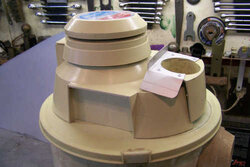
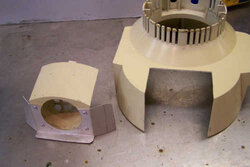
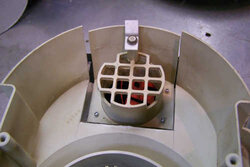
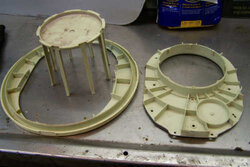
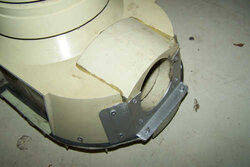
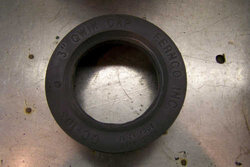
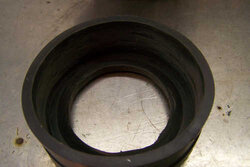
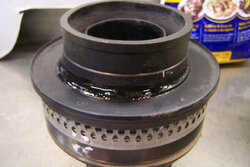
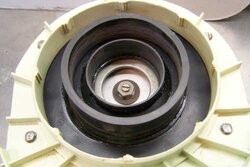
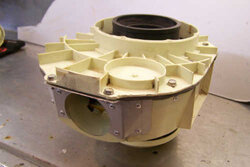

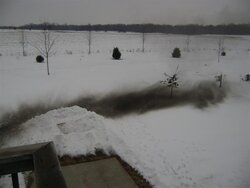
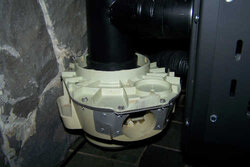
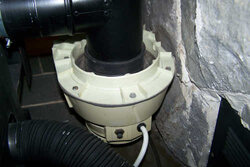
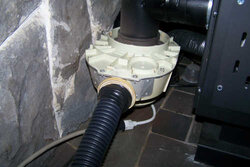
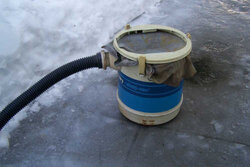
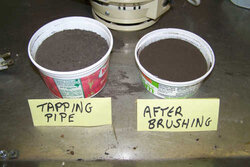
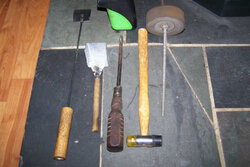
 !
!